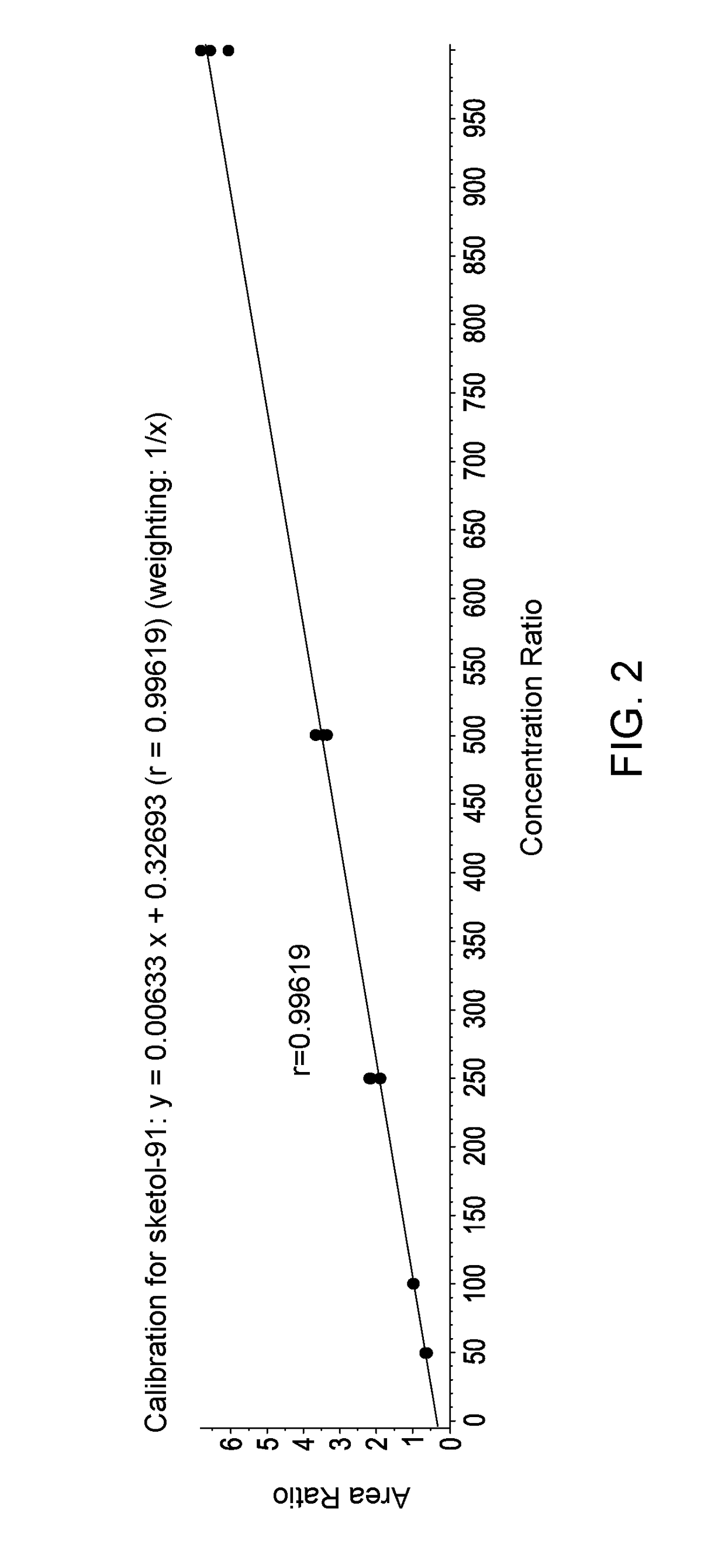Method for detecting boar taint
a boar taint and odour technology, applied in the field of methods for detecting odour or taste in meat, can solve the problems of poor meat tenderness, bitter taste, unsatisfactory smell,
- Summary
- Abstract
- Description
- Claims
- Application Information
AI Technical Summary
Benefits of technology
Problems solved by technology
Method used
Image
Examples
example 1
[0134]Experiments were conducted to prepare standard solutions of known concentrations of androstenone, skatole or indole. The standard solutions were prepared by SALLE of minced pig backfat samples, as follows:[0135]0.5 g of minced pig backfat which did not contain boar taint compounds was homogenized in a mixture of 1.5 mL of saturated NaCl solution and 1.5 mL of an internal standard solution of skatol-d3 (50 ppb) and androstenone-d4 (500 ppb) in acetonitrile;[0136]the mixture obtained was vortex mixed and centrifuged, and the upper fraction (acetonitrile fraction) was collected;[0137]a known concentration of androstenone, skatole and indole was added in each standard solution.
[0138]The concentrations in androstenone, skatole and indole are shown in Tables 1 to 3 for each one of the standard solutions prepared. Skatole-d3 was used as the internal standard for both skatole and indole.
TABLE 1Standard solutions of known concentrations of androstenone,skatole and indoleSkatoleIndoleSt...
example 2
[0140]Experiments were conducted to measure the concentration of androstenone, skatole and indole in the standard solutions listed in Table 1 of Example 1, using a method according to an embodiment of the present description.
[0141]Each standard solution was submitted to the following derivatization procedure:[0142]10 to 20 mg of KOH powder was added to 100 μl of the standard solution in anhydrous conditions (acetonitrile fraction of Example 1 to which androstenone, skatole and indole were added);[0143]10 μl of a benzyl bromide solution (10% v / v in acetonitrile) was added;[0144]the mixture obtained was vortex mixed and the reaction was allowed to go on for 5 minutes at room temperature;[0145]400 μl of an EDTA buffer (0.25M, pH 8) was added;[0146]400 μl of a hexane / ethyl acetate mixture (90 / 10 v / v) was added;[0147]the mixture was vortex mixed and the two phases were allowed to separate;[0148]5 μl of the upper layer phase was deposited onto a LazWell™ well surface and allowed to dry at...
example 3
[0160]Experiments were conducted to measure the concentration of androstenone, skatole and indole in the standard solutions listed in Table 1 of Example 1, using a method according to another embodiment of the present description.
[0161]Each standard solution was submitted to the following derivatization procedure:[0162]20 μl of a sodium bis(trimethylsylil) amide (NaHMDS) solution in THF (1.0M) was added to 100 μl of the standard solution (acetonitrile fraction of Example 1 to which androstenone, skatole and indole were added) in ambient conditions;[0163]The mixture was vortex mixed;[0164]10 μl of a 2,3,4,5,6-pentafluorobenzyl bromide solution (10% v / v in acetonitrile) was added;[0165]the mixture obtained was vortex mixed and the reaction was allowed to go on for 5 minutes at 37° C.;[0166]400 μl of a hexane / ethyl acetate mixture (90 / 10 v / v) was added;[0167]the mixture was vortex mixed and the two phases were allowed to separate;[0168]2 μl of the upper layer phase was deposited onto a...
PUM
 Login to View More
Login to View More Abstract
Description
Claims
Application Information
 Login to View More
Login to View More - R&D
- Intellectual Property
- Life Sciences
- Materials
- Tech Scout
- Unparalleled Data Quality
- Higher Quality Content
- 60% Fewer Hallucinations
Browse by: Latest US Patents, China's latest patents, Technical Efficacy Thesaurus, Application Domain, Technology Topic, Popular Technical Reports.
© 2025 PatSnap. All rights reserved.Legal|Privacy policy|Modern Slavery Act Transparency Statement|Sitemap|About US| Contact US: help@patsnap.com



